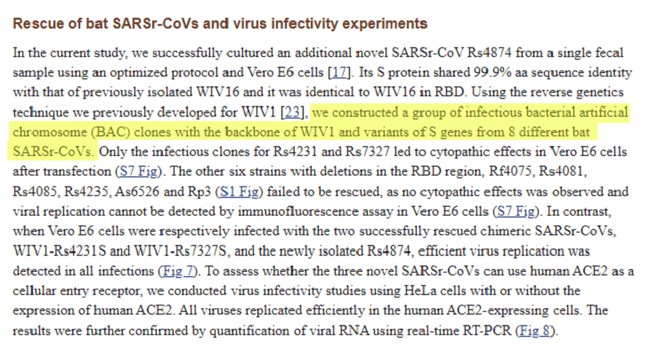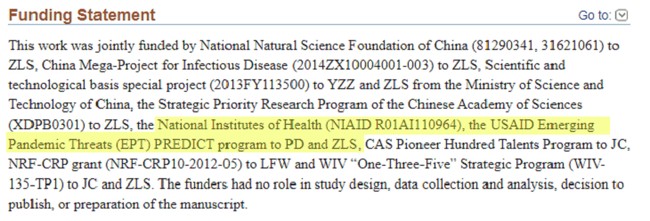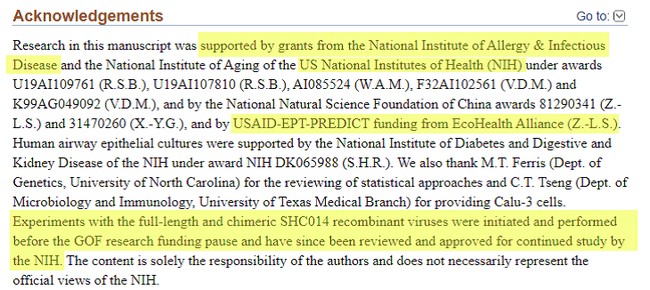(This is Part III of an article series detailing Dr. Fauci’s funding of DURC / Gain-of-function research through the NIH and NIAID. Part I can be found here and Part II can be found here.)
At this point, one thing is for sure: NIAID Director Dr. Anthony Fauci has been less than truthful about his statements on viral gain-of-function research. As we concluded yesterday, not only was Dr. Ralph Baric of the University of North Carolina unquestionably conducting NIH/NIAID-funded gain-of-function research with Dr. Shi Zhengli of the Wuhan Institute of Virology, but that research was likely performed contrary to the directive of the US Department of Health and Human Services.
This series of articles thus far could be summed up with two very simple questions:
- What research has Dr. Fauci Funded?
- Where was that research conducted?
It is indisputable that Dr. Fauci’s NIAID has funded gain-of-function research at the University of Wisconsin, The University of Tokyo, Erasmus University in the Netherlands, as well as other universities and labs across the country and around the world. As I have previously covered, there are two statements made by Dr. Fauci that either make him woefully misinformed about his own organization or a bald-faced liar.
- That the Dr. Ralph Baric did not conduct gain-of-function research.
- That if he did, that the research was within the bounds established by HHS.
As covered in Part II, Baric and UNC were requested to cease gain-of-function research on the SARS virus as well as other Influenza and Ebola research, and the NIAID was ordered to cease funding gain-of-function research after the end of the “[then] current active budget period,” or, the annual period in which the funding was authorized. In the case of Dr. Baric’s research, that was May 31st, 2015, or just over seven months after the ordered gain-of-function research pause. When May 31st, 2015 rolled around, Baric’s research was reauthorized by the NIAID, the same in 2016. In 2017, the project was again reauthorized this time, including over $835,000 in funding. The HHS did not lift the NIAID ban on funding until December 2017. For Dr. Fauci to state that Baric didn’t perform gain-of-function research (he does) and that if he did it was within the bounds established by the HHS (it wasn’t), is flat-out untrue. The HHS would not have oversight of research conducted without their authorization or (presumably) their knowledge.
And the misinformation continues.
Among other statements that Fauci made was that the NIH has never funded gain-of-function research at the Wuhan Institute of Virology. This again appears to be either a woeful misunderstanding of the facts including funding authorizations by his own organization, or a purposeful and intentional attempt to lie.
The first is in determining who the decision-makers are at EcoHealth Alliance. Founded in 1971 and changing its name in 2010, EcoHealth Alliance is “a global environmental health nonprofit organization dedicated to protecting wildlife and public health from the emergence of disease.” The organization’s President is a guy by the name of Peter Daszak, a zoologist and Doctor of Parasitic Infectious Diseases. Daszak has been with the EcoHealth Alliance for the last couple of decades.
Daszak, who has been extremely critical of the theory of a release from the Wuhan Institute of Virology, has suddenly found himself at the center of this growing controversy. Daszak has, over the course of the last several years, conducted numerous experiments with Dr. Shi Zhengli of the Wuhan Institute of Virology. In fact, if we analyze the type of experiments being conducted by Zhengli and Daszak at the WIV, one can conclude that at the very least their research would make it easier to conduct gain-of-function research.
At this point, let’s acknowledge that a few things are not being questioned or refuted by Fauci, the NIH, and the NIAID. The first is that the NIH has funded coronavirus research through EcoHealth Alliance and Peter Daszak. The second is that that funding was used to study coronavirus genetic sequencing at the Wuhan Institute of Virology. We also need to acknowledge that Daszak and EcoHealth Alliance’s mission is an admirable one. Certainly, their research could be used to protect millions of people from the advent or spread of a new deadly coronavirus. What needs to also be recognized, though, is the chance that one of these viral experiments could accidentally be released from a lab conducting these types of experiments as well as the potential that this type of research could be used to create a bioweapon.
When we previously discussed Dual Use Research Of Concern (DURC), we were referring to the fact that gain-of-function experiments have the potential of creating both treatments for a viral infection and a deadly, highly transmissible viral bioweapon. EcoHealth Alliance has also teamed up with the US Agency for International Development (USAID) on its emerging threats program, PREDICT, to identify and catalog new, potentially dangerous viral strains.
Daszak and Shi’s experiments on viruses primarily focused on the identification of naturally occurring coronavirus strains and the genomic sequencing of each of these identified viruses. Presumably, by identifying these new viruses and their genomic code researchers could, at a moment’s notice, begin providing anti-viral treatments and vaccines for the new viral threat. Again, an admirable pursuit. Their research was not, however, relegated to this type of research only. Other types of research focused on identifying potential new mutations of a particular viral strain, however, that does not mitigate the risk of accidental creation of a new deadlier virus or providing the map for more nefarious actions. The purpose of revealing this information is not to question Daszak and Shi’s initial intent behind their gain-of-function research.
In 2013, Daszak and Shi were among the authors of a study that isolated and identified a new type of coronavirus WIV1, which was found through sampling bat feces obtained from caves in the Yunnan Province of China. This new virus was determined to be among the closest related viruses to SARS-CoV identified to date. Again, no one should fault these scientists for identifying naturally occurring viruses. This study was also funded by the NIH and the NIAID.
It was later, however, that Daszak and Shi, under newly acquired funding from the NIH, conducted experiments to genetically modify the WIV1-CoV strain. In 2016, Daszak and Shi conducted experiments in “Construction of WIV1 mutants.” This experiment used bacteria as the host to replicate genetically altered viral strains. Should the bacteria replicate the viral strain, the replicated virus is then harvested or “rescued” and cataloged. This particular research produced two mutated viral strains, rWIV1-ΔX and rWIV1-GFP-ΔX. Those viral strains, among others, were then tested in comparison with “wild-type” WIV1 and were found to inhibit the production of interferons or a viral enzyme that alerts your immune system to the presence of a viral infection.
In other words, the genetically altered viruses were more virulent than their natural predecessor.

In 2017, Daszak and Shi conducted experiments that included genetically combining the “backbone of WIV1 and variants of S genes from 8 different bat SARSr-COVs.” Of those 8, 6 failed to replicate. The two that did replicate were “rescued” and then used to infect “immortal” monkey cells (known as Vero E6 cells). Those two viral mutations were found to replicate causing the study to then test the mutant viruses on HeLa cells or immortal human cells used in laboratory testing. The mutated viral strains were also able to infect those cells.

Now again, EcoHealth Alliance, Daszak, and Shi have been vehement in their denials about the performance of gain-of-function research at the Wuhan Institute of Virology. In fact, EcoHealth Alliance has gone as far as to state that they do not perform gain-of-function research. As a result, they likely would claim that the above-referenced experiments on WIV1 would not qualify as gain-of-function. The godfather of gain-of-function, Dr. Ralph Baric, would disagree with that.
As previously discussed, Dr. Baric and Dr. Shi of the WIV conducted gain-of-function research, funded by the NIH in 2015. The viral strain used, SHC014, was mutated with gain-of-function research to create SHC014-MA15. The mutated virus was then used to infect Vero E6 and human airway cells. This research is identical to that done by Daszak and Shi at the WIV on WIV1. Any debate about whether or not this qualifies as gain-of-function is put to rest by a disclosure included in Baric’s study.

The disclosure reads, in part:
These studies were initiated before the US Government Deliberative Process Research Funding Pause on Selected Gain-of-Function Research Involving Influenza, MERS, and SARS Viruses. This paper has been reviewed by the funding agency, the NIH. Continuation of these studies was requested, and this has been approved by the NIH.
What if they want to argue that SHC014-MA15 is different than WIV1? Thankfully, we have an answer. In 2016, Dr. Baric conducted identical research to that performed by Daszak and Shi, with mutating the WIV1 virus and then using those mutations to infect Vero E6 cells and human airway epithelial cells. That research also carried with it, the acknowledgment that it was gain-of-function research and that that research is approved and reviewed by the NIH.

To question whether or not this research is “gain-of-function” is absolutely asinine. As we have previously defined, gain-of-function research is the genetic altering of viruses so that they become more infectious or deadly. Without a doubt, the genetic alteration of a virus which then, in turn, inhibits an immune response is inherently enhancing the pathogenic ability of a virus.
To make matters worse is that Fauci’s testimony before Sen. Rand Paul can, with almost total confidence, be labeled as misinformation, as covered by Bonchie here at RedState. All four of the above-mentioned studies included Dr. Shi Zhengli as an author or contributor, were conducted at the WIV, and/or were funded either totally or in part by the NIH and/or EcoHealth Alliance through NIH grants:



The last part of that acknowledgment section reads:
“Experiments with the full-length and chimeric SHC014 recombinant viruses were initiated and performed before the GOF research funding pause and have since been reviewed and approved for continued study by the NIH.”

The acknowledgment section of this study reads in part:
“We thank Dr. Zhengli-li Shi of the Wuhan Institute of Virology for access to bat CoV sequences and plasmid of WIV1-CoV spike protein. Research was supported by the National Institute of Allergy and Infectious Disease and the National Institute of Aging of the NIH under Awards U19AI109761 and U19AI107810 (to R.S.B) [Ralph S. Baric]….”
Check back tomorrow for Part IV as we dive into the insane amount of conflicts of interest of Peter Daszak.













Join the conversation as a VIP Member